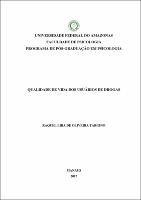| ???jsp.display-item.social.title??? |


|
Please use this identifier to cite or link to this item:
https://tede.ufam.edu.br/handle/tede/5706| ???metadata.dc.type???: | Dissertação |
| Title: | Qualidade de vida dos usuários de drogas |
| ???metadata.dc.creator???: | Targino, Raquel Lira de Oliveira  |
| ???metadata.dc.contributor.advisor1???: | Hayasida, Nazaré Maria de Albuquerque |
| ???metadata.dc.contributor.referee1???: | Andretta, Ilana |
| ???metadata.dc.contributor.referee2???: | Becker, Maria Alice d'Avila |
| ???metadata.dc.contributor.referee3???: | Presa, Luis Alberto Passos |
| ???metadata.dc.contributor.referee4???: | Galdino, Melyssa Kellyane Cavalcanti |
| ???metadata.dc.description.resumo???: | As investigações sobre Qualidade de Vida (QV) têm sido cada vez mais frequentes, uma vez que é sabido que QV influencia a saúde e também é por ele influenciada. Desta forma, compreender a percepção de QV dos indivíduos tem sido importante para avaliar o impacto das intervenções nos mais diversos serviços de saúde. Esta pesquisa teve por objetivo analisar a QV de usuários de drogas internados para tratamento em uma instituição pública de saúde na cidade de Manaus. Trata-se de pesquisa quantitativo-descritivo, de corte transversal, com 52 pacientes internados para tratamento no Centro de Reabilitação em Dependência Química Ismael Abdel Aziz (CRDQ). Foram utilizados o instrumento SF-36 e questionário sócio demográfico, aplicados em dois momentos distintos. Os dados foram analisados através dos programas estatísticos Excel 2010 (Microsoft Office Enterprise) e Statistic Package for the Social Sciences (SPSS), versão 17.0. Evidenciou-se predomínio de homens solteiros, entre 18 a 27 anos. Relataram ter o oxi como droga de dependência, seguido da cocaína, consumidos todos os dias, há pelo menos 2 anos. Referiram possuir familiar usuário de drogas, sendo os irmãos os mais citados. A QV no início do tratamento apresentou-se prejudicada, com baixos escores nos componentes físico (M=60) e (DP=17,23) e mental (M=49) e (DP=17,63). Contudo, após três meses de tratamento houve melhora significativa nos escores dos referidos componentes, para (M=88,6), (DP=10,85) e (M=82,2), (DP=16,72) respectivamente. Destacaram-se ainda os domínios capacidade funcional (M=69), (DP=18,05) e vitalidade (M=58,8), (DP=20,04), com baixos escores iniciais. Apresentando, contudo, escores mais elevados ao final do tratamento, sendo (M=95,3), (DP=9,54) e (M=86,8), (DP=13,58), respectivamente. Concluiu-se que as intervenções terapêuticas realizadas pela equipe multiprofissional contribuíram para a melhora na percepção de QV dos pacientes, bem como na adesão ao tratamento. |
| Abstract: | Researches about Quality of Life (QoL) has been increasingly frequent since it is known that QoL influences health and is also influenced by it. In this way, understand the perception of QoL of the individuals has been important to evaluate the impact of the interventions in the most different health services. The objective of this research was to analyze the QoL of drug users hospitalized for treatment in a public health institution in the city of Manaus. This is a quantitative-descriptive, cross-sectional study with 52 patients hospitalized for treatment at the Ismael Abdel Aziz Chemical Dependency Rehabilitation Center (CRDQ). The SF-36 and the socio-demographic questionnaire were used, applied in two different moments. The data were analyzed through statistical programs Excel 2010 (Microsoft Office Enterprise) and Statistic Package for the Social Sciences (SPSS), version 17.0. It was evidenced a predominance of single men, between 17 and 27 years. They reported having oxy as a drug of dependence, followed by cocaine, consumed every day for at least 2 years. They reported having a familiar drug user, with the brothers being the most cited. QoL at the beginning of treatment was impaired, with low scores in the physical (M=60), (DP=17,23) and mental (M=49), (DP=17,63) components. However, after three months of treatment there was a significant improvement in the scores of these components, for (M=88,6), (DP=10,85) and (M=82,2), (DP=16,72), respectively. The functional capacity domains (M=69), (DP=18,05) and vitality (M=58,8), (DP=20,04), were also highlighted, with low initial scores. However, there were higher scores at the end of treatment, being (M=95,3), (DP=9,54) and (M=86,8), (DP=13,58), respectively. It was concluded that the therapeutic interventions carried out by the multiprofessional team contributed to the improvement in the patients' QoL perception, as well as their adherence to the treatment. |
| Keywords: | Usuários de drogas Sistema Unico de Saúde Qualidade de vida Drug users Unified Health System Quality of Life |
| ???metadata.dc.subject.cnpq???: | CIENCIAS HUMANAS: PSICOLOGIA |
| Language: | por |
| ???metadata.dc.publisher.country???: | Brasil |
| Publisher: | Universidade Federal do Amazonas |
| ???metadata.dc.publisher.initials???: | UFAM |
| ???metadata.dc.publisher.department???: | Faculdade de Psicologia |
| ???metadata.dc.publisher.program???: | Programa de Pós-graduação em Psicologia |
| Citation: | TARGINO, Raquel Lira de Oliveira. Qualidade de vida dos usuários de drogas. 2017. 190 f. Dissertação (Mestrado em Psicologia) - Universidade Federal do Amazonas, Manaus, 2017. |
| ???metadata.dc.rights???: | Acesso Aberto |
| ???metadata.dc.rights.uri???: | http://creativecommons.org/licenses/by-nc-nd/4.0/ |
| URI: | http://tede.ufam.edu.br/handle/tede/5706 |
| Issue Date: | 31-Mar-2017 |
| Appears in Collections: | Mestrado em Psicologia |
Files in This Item:
| File | Description | Size | Format | |
|---|---|---|---|---|
| Dissertação - Raquel Lira de Oliveira Targino.pdf | 2.3 MB | Adobe PDF |  Download/Open Preview |
This item is licensed under a Creative Commons License





